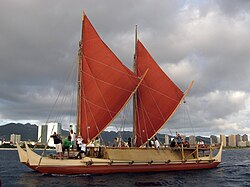
A tongkang is a boat used to carry goods along rivers and shores in Maritime Southeast Asia. [1] One of the earliest written records of tongkangs is in the Malay Annals, which was composed no earlier than the 17th century. One passage mentions them being used by the Majapahit Empire during the 1350 attack on Singapura. [2]








